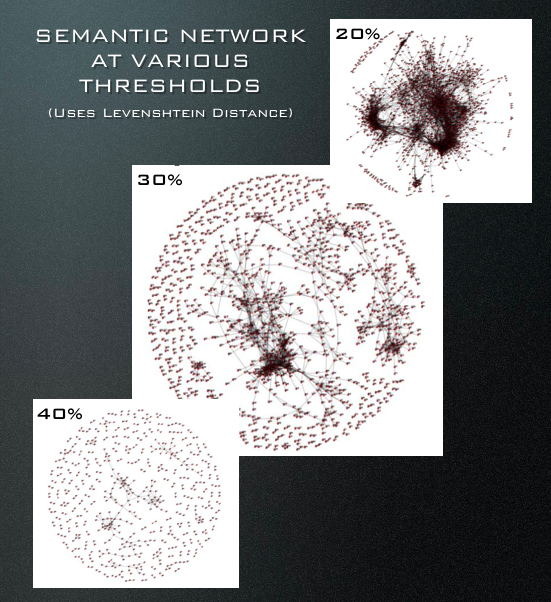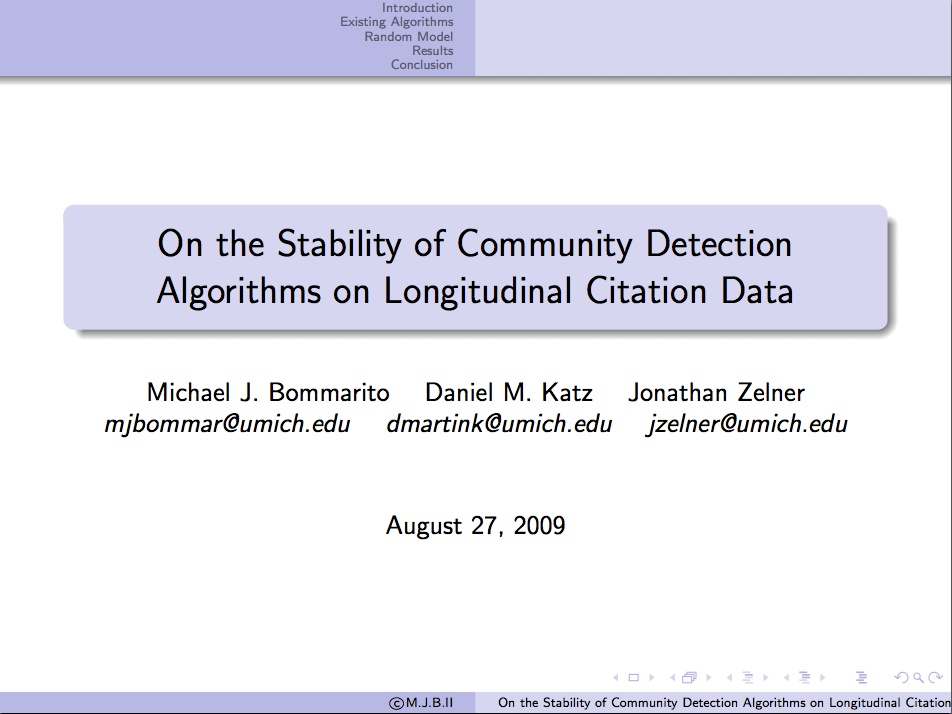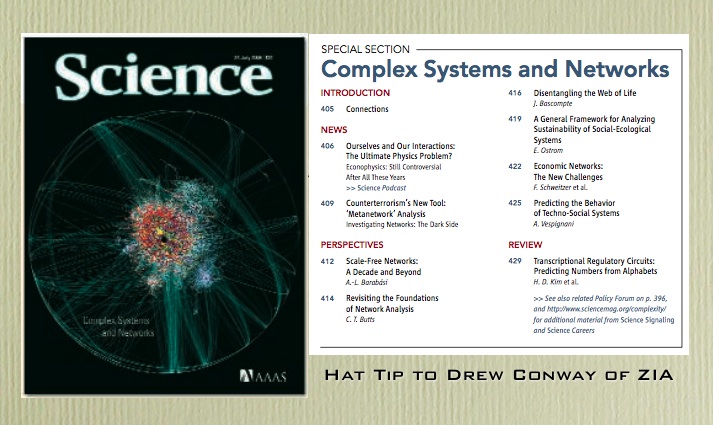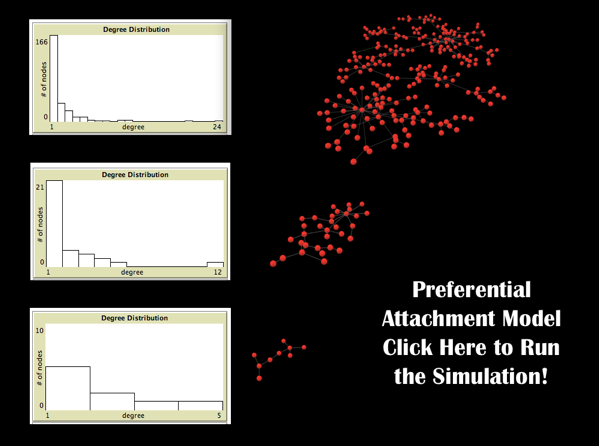There are a number of high quality interdisciplinary research groups here at Michigan. We are working with one of these groups — The Political Networks Lab. It is led by Michael Heaney (now here at Michigan in Organizational Studies). Michael is the author of numerous publications and was recently the guest editor of a special issue of American Politics Research. We wanted to highlight this recent issue as there are a number of articles that might be of interest. Click above to view the contents!
Tag: network analysis
Positive Legal Theory and a Model of Intellectual Diffusion on the American Legal Academy [Repost from 4/22]
 For the third installment of posts related to Reproduction of Hierarchy? A Social Network Analysis of the American Law Professoriate, we offer a Netlogo simulation of intellectual diffusion on the network we previously visualized. As noted in prior posts, we are interested legal socialization and its role in considering the spread of particular intellectual or doctrinal paradigms. This model captures a discrete run of the social epidemiological model we offer in the paper. As we noted within the paper, this represents a first cut on the question—where we favor parsimony over complexity. In reality, there obviously exist far more dynamics than we engage herein. The purpose of this exercise is simply to begin to engage the question. In our estimation, a positive theory of law should engage the sociology of the academy — a group who collectively socialize nearly every lawyer and judge in the United States. In the paper and in the model documentation, we offer some possible model extensions which could be considered in future scholarship.
For the third installment of posts related to Reproduction of Hierarchy? A Social Network Analysis of the American Law Professoriate, we offer a Netlogo simulation of intellectual diffusion on the network we previously visualized. As noted in prior posts, we are interested legal socialization and its role in considering the spread of particular intellectual or doctrinal paradigms. This model captures a discrete run of the social epidemiological model we offer in the paper. As we noted within the paper, this represents a first cut on the question—where we favor parsimony over complexity. In reality, there obviously exist far more dynamics than we engage herein. The purpose of this exercise is simply to begin to engage the question. In our estimation, a positive theory of law should engage the sociology of the academy — a group who collectively socialize nearly every lawyer and judge in the United States. In the paper and in the model documentation, we offer some possible model extensions which could be considered in future scholarship.
Once you click through to the model, here is how it works:
(1) Click the Setup Button in the Upper Left Corner. This will Display the Network in the Circular Layout.
(2) Click the Layout Button. Depending upon the speed of your machine this may take up to 30 seconds. Stop the Layout Button by Re-Clicking the Button.
(3) Click the Size Nodes by Degree Button. You Will Notice the Fairly Central Node Colored in Red. This is School #12 Northwestern University Law School. Observe how we have set the default infected school as #12 Northwestern (Hat Tip to Uri Wilensky). A Full List of School Number is available at the bottom of the page when you click through.
(4) Now, we are ready to begin. Click the Spread Once Button. The idea then reaches its neighbors with probability p (set as a default at .05). You can click the Toggle Infection Tree button (at any point) to observe the discrete paths traversed by the idea.
(5) Click the Spread Once Button, again and again. Notice the plot tracking the time on the x axisand the number of institution infected on the y axis. This is an estimate of the diffusion curve for the institution.
(6) To restart the simulation, click the Reinfect One button. Prior to hitting this button, slide theInfected Slider to any Law School you would like to observe. Also, feel free to adjust the p slider to increase or decrease the infectiousness of the idea.
Please comment if you have any difficulty or questions. Note you must have Java 1.4.1 + installed on your computer. The Information Technology professionals at many institutions will have already installed this on your machine but if not you will need to download it. We hope you enjoy!
ASNA 2009 @ University of Zurich / ETH Zurich
Mike and I are on the road traveling to the ASNA 2009 in Zurich. We will be presenting our paper On the Stability of Community Detection Algorithms on Longitudinal Citation Data at the conference. In addition, I will be chairing one of the panels on Economic Networks. We are exciting for the meeting but as a function of the travel … it will light blogging during this upcoming week.
Sea Dragon Visualization of the American Legal Academy
Here is another visual run through the SeaDragon Visualization from Microsoft Labs. Similar to the Title 17 United States Code visual from earlier in the week, one can zoom in and out. Using the button in the far southeast corner it is possible to generate a full screen visual of the network.
Pervious posts discussing this visualization are located here and here. In addition, results of our model of diffusion on the network are located here while an interactive version of the agent based model generated in Netlogo is located here. For those interested in the full draft … it is entitled Reproduction of Hierarchy? A Social Network Analysis of the American Law Professoriate.
Law in Structure of Academic Disciplines [Repost]

This article offers a very interesting insight into the structure of academic disciplines. Using a variety of sources, the authors collected nearly 1 billion interactions from scholarly web portals including Thomson Scientific, Elsevier, JSTOR, etc.
Residing between Economics, Sociology and International Studies, notice the location for legal studies in the upper center portion of this screen print.
The Full Size visualization as well as relevant analytics are available within the paper. Among other things, the approach undertaken by Johan Bollen, Herbert Van de Sompel, Aric Hagberg, Luis Bettencourt, Ryan Chute, Marko A. Rodriguez & Lyudmila Balakireva provides an alternative view of the current structure of the academic disciplines from that offered in existing bibliometric studies.
Power Laws, Preferential Attachment and Positive Legal Theory [Part 1]
The visual above is drawn from the Netlogo Simulation of preferential attachment. “In the model, a given node prefers to connect to other nodes that already display high indegree. As the number of connections a given agent displays is a function of the number the agent possessed in earlier time periods, the distribution of connections is highly susceptible to the initial starting conditions. For instance, consider a network that has four nodes A, B, C and D where A is connected to B and C is connected to D. If node E enters the network, assume the initial probability of attachment to the AB community is equal to that of the CD community. Once E connects to either the AB or CD community, subsequent entrants such as node F, G and beyond are more likely to connect with the community selected by E.” The model offers one of the generative processes responsible for creating a network with a power law distribution.
There are important differences between the abstract model as initially described in Albert-László Barabási & Reka Albert, Emergence of Scaling in Random Networks, 286 Science 509 (1999) and the dynamics of broader social world. While a number of extensions of the model have been authored in the period following the original article, what is striking is how much leverage on basic dynamics can be gleaned from the graph analog of a Yule process.
For purposes of positive legal theory consider the following passage … “In order to contextualize what a particular observed network structure implies, it is critical to remember that the social landscape need not take any particular form. Scaffolding could indeed assume a variety of flavors and there are causal mechanisms that act at the micro-level to produce the observed macro-architecture.” While such distributions have been documented in a variety of context relevant for positive legal theory, it is important to note this distribution of social authority is by no means a given. Specifically, as we described in Social Architecture, Judicial Peer Effects and the ‘Evolution’ of the Law: Toward a Positive Theory of Judicial Social Structure social systems can embrace a wide variety of architectures. Thus, we believe the documented tendency of common law and its constitutive systems to generate such highly skewed distributions is highly relevant.
In Part II of this post, we will highlight the current state of the relevant applied legal literature. This includes not only our work but also important studies by a wide number of other legal scholars. To preview, check out this post from a few days ago…
Law as a Seamless Web? Part III
This is the third installment of posts related to our paper Law as a Seamless Web? Comparison of Various Network Representations of the United States Supreme Court Corpus (1791-2005) previous posts can be found (here) and (here). As previewed in the earlier posts, we believe comparing the Union, the Intersect and the Compliment of the SCOTUS semantic and citation networks is at the heart of an empirical evaluation of Law as a Seamless Web …. from the paper….
“Though law is almost certainly a web, questions regarding its interconnectedness remain. Building upon themes of Maitland, Professor Solum has properly raised questions as to whether or not the web of law is “seamless”. By leveraging the tools of computer science and applied graph theory, we believe that an empirical evaluation of this question is at last possible. In that vein, consider Figure 9, which offers several possible topological locations that might be populated by components of the graphs discussed herein. We believe future research should consider the relevant information contained in the union, intersection, and complement of our citation and semantic networks.
While we leave a detailed substantive interpretation for subsequent work, it is worth broadly considering the information defined in Figure 9. For example, the intersect (∩) displayed in Figure 9 defines the set of cases that feature both semantic similarity and a direct citation linkage. In general, these are likely communities of well-defined topical domains. Of greater interest to an empirical evaluation of the law as a seamless web, is likely the magnitude and composition of the Citation Only and Semantic Only subsets. Subject to future empirical investigation, we believe the Citation Only components of the graph may represent the exact type of concept exportation to and from particular semantic domains that would indeed make the law a seamless web.”
The Rise of the Data Scientist [From Flowing Data]
Earlier in the month, there was a very interesting discussion over at Flowing Data entitled the Rise of the Data Scientist. We decided to highlight it in this post because it raises important issues regarding the relationship between Computational Legal Studies and other movements within law.
As we consider ourselves empiricists, we are strong supporters of the Empirical Legal Studies movement. For those not familiar, the vast majority of existing Empirical Legal studies employ the use of econometric techniques. For some substantive questions, these approaches are perfectly appropriate. While for others, we believe techniques such as network analysis, computational linguistics, etc. are better suited. Even when appropriately employed, as displayed above, we believe the use of traditional statistical approaches should be seen as nested within a larger process. Namely, for a certain class of substantive questions, there exists tremendous amounts of readily available data. Thus, on the front end, the use of computer science techniques such as web scraping and text parsing could help unlock existing large-N data sources thereby improving the quality of inferences collectively produced. On the back end, the use of various methods of information visualization could democratize the scholarship by making the key insights available to a much wider audience.
It is worth noting that our commitment to Computational Legal Studies actually embraces a second important prong. From a mathematical modeling/formal theory perspective, at least for a certain range of questions, agent based models/computational models ≥ closed form analytical models. In other words, we are concerned that many paper & pencil game theoretic models fail to incorporate interactions between components or the underlying heterogeneity of agents. Alternatively, they demonstrate the existence of a P* without concern of whether such an equilibrium is obtained on a timescale of interest. In some instances, these complications do not necessarily matter but in other cases they are deeply consequential.
Collaboration Among Political Science Network Scholars
 At the recent Networks in Political Science Conference (Harvard 2009), Ramiro Berardo from Arizona presented a paper entitled Networking Networkers: An Exploration of the Patterns of Collaboration among Attendees to the First Harvard Political Networks Conference. The above visual displays the patterns of collaboration among the growing networks community within Political Science. Major scholars in the field including James Fowler, John Scholz, David Lazar and Scott McClurg are displayed. In the northeast corner of the graph you can observe yours truly, Daniel Katz. At the rate he is going, it will not be long until there is a large and central Bommarito node on this graph.
At the recent Networks in Political Science Conference (Harvard 2009), Ramiro Berardo from Arizona presented a paper entitled Networking Networkers: An Exploration of the Patterns of Collaboration among Attendees to the First Harvard Political Networks Conference. The above visual displays the patterns of collaboration among the growing networks community within Political Science. Major scholars in the field including James Fowler, John Scholz, David Lazar and Scott McClurg are displayed. In the northeast corner of the graph you can observe yours truly, Daniel Katz. At the rate he is going, it will not be long until there is a large and central Bommarito node on this graph.
Law as a Seamless Web? Part II

In our paper Law as a Seamless Web, we offer a first-order method to generate case-to-case and opinionunit-to-opinionunit semantic networks. As constructed in the figure above, nodes represent cases decided between 1791-1865 while edges are drawn when two cases possess a certain threshold of semantic similarity. Except for the definition of edges, the process of constructing the semantic graph is identical to that of the citation graph we offered in the prior post. While computer science/computational linguistics offers a variety of possible semantic similarity measures, we choose to employ a commonly used measure. Here a description from the paper:
“Semantic similarity measures are the focus of significant work in computational linguistics. Given the scope of the dataset, we have chosen a first-order method for calculating similarity. After lemmatizing the text of the case with WordNet, we store the nouns with the top N frequencies for each case or opinion unit. We define the similarity between two cases or opinion units A and B as the percentage of words that are shared between the top words of A and top words of B.
 An edge exists between A and B in the set of edges if σ (A,B) exceeds some threshold. This threshold is the minimum similarity necessary for the graph to represent the presence of a semantic connection.”
An edge exists between A and B in the set of edges if σ (A,B) exceeds some threshold. This threshold is the minimum similarity necessary for the graph to represent the presence of a semantic connection.”
As this a technical paper, it is slanted toward demonstrating proof of methodological concept rather than covering significant substantive ground. With that said, we do offer a hint of our broader substantive goal of detecting the spread of legal concepts between various topical domains. Specifically, with respect to enriching positive political theory, we believe union, intersect and compliment of the semantic and citation networks are really important. More on this point is forthcoming in a subsequent post…
Law as a Seamless Web?
We have recently posted Law as a Seamless Web? Comparison of Various Network Representations of the United States Supreme Court Corpus (1791-2005) to the SSRN. Given this is the first of several posts about the paper, I will speak broadly and leave details for a subsequent post. From the abstract “As research of judicial citation and semantic networks transitions from a strict focus on the structural characteristics of these networks to the evolutionary dynamics behind their growth, it becomes even more important to develop theoretically coherent and empirically grounded ideas about the nature of edges and nodes. In this paper, we move in this direction on several fronts …. Specifically, nodes represent whole cases or individual ‘opinion units’ within cases. Edges represent either citations or semantic connections.” The table below outlines several possible network representations for the USSC corpus.
The goal of the paper is to do some technical and conceptual work. It is a small slice of broader project with James Fowler (UCSD) and James Spriggs (WashU). We recently presented findings from the primary project at the Networks in Political Science Conference. The main project is entitled The Development of Community Structure in the Supreme Court’s Network of Citations and we hope to have a version of this paper on the SSRN soon. In the meantime, we plan additional discussion of Law as a Seamless Web in the days to come.



![IPMZ-ASNA[1] IPMZ-ASNA[1]](http://computationallegalstudies.com/wp-content/uploads/2009/08/IPMZ-ASNA1.gif)







